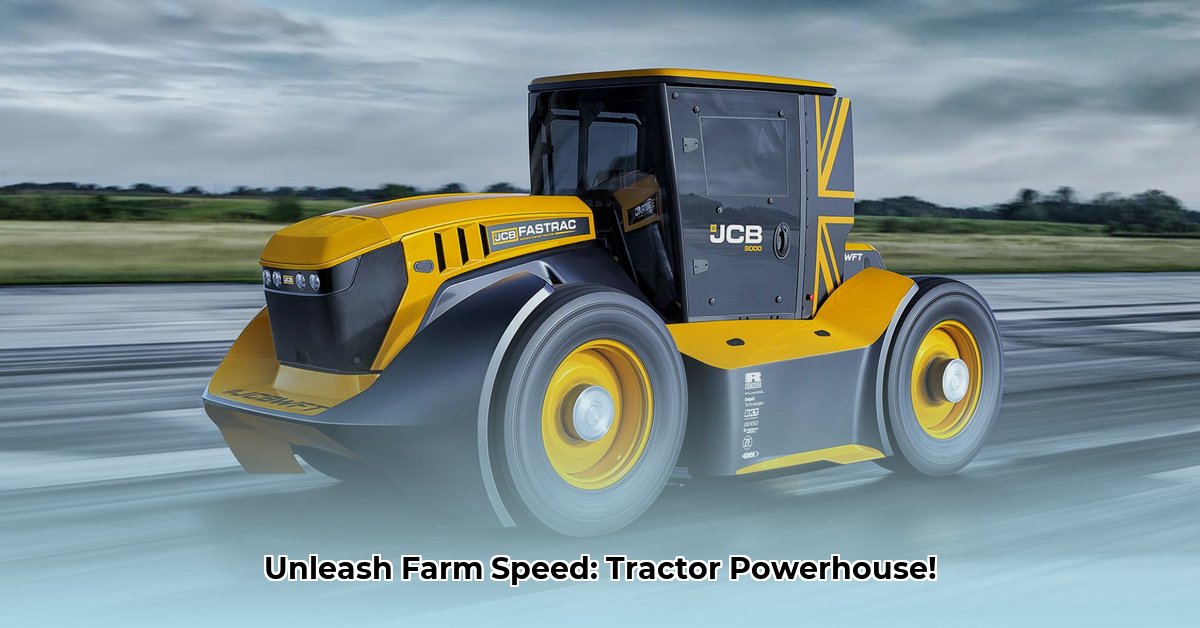
Fastest Tractor Technology: Is Speed the Key to a More Efficient Farm?
The agricultural landscape is undergoing a transformation, with speed emerging as a critical factor in farm efficiency. For decades, tractor power was the primary metric; today, manufacturers are prioritizing velocity, developing machines capable of unprecedented speeds. But does this pursuit of speed truly translate to enhanced farm efficiency? This article delves into the engineering innovations behind high-speed tractors, examining their practical implications and potential impact on modern agriculture. We will explore the technological advancements, comparative analysis of leading models, and the crucial safety considerations involved in this rapidly evolving sector. For more resources on financing your new high-speed tractor, check out this helpful site.
The Pursuit of Speed: Engineering Marvels on Wheels
Several key advancements are driving the high-speed tractor revolution. Modern tractors utilize powerful diesel engines, often incorporating turbocharging and other advanced technologies to maximize horsepower while minimizing fuel consumption. However, engine power alone isn't sufficient; aerodynamics play a pivotal role. High-speed tractors are designed with streamlined bodies, similar to race cars, to reduce drag and improve fuel efficiency, contributing to increased speed and reduced operational costs. Finally, specialized tire designs, incorporating high-performance materials and tread patterns, are critical for maintaining stability and traction at higher speeds, even on uneven terrain. The integration of advanced safety systems is paramount, ensuring operator safety and mitigating potential risks associated with increased velocity.
Meet the Speedsters: A Comparative Analysis
Several manufacturers are at the forefront of the high-speed tractor development. While precise top speeds can vary depending on testing conditions and model configurations, the JCB Fastrac series consistently ranks among the fastest commercially available tractors. Other manufacturers are also producing high-speed models, incorporating similar technological advancements. The following table (though not exhaustive) highlights key performance specifications of leading models:
| Tractor Model | Estimated Top Speed (mph) | Horsepower Range | Weight (lbs) (Approximate) | Notable Features |
|---|---|---|---|---|
| JCB Fastrac | 70+ | Varies | Varies | Exceptional aerodynamics, powerful engine, renowned reliability |
| [Other High-Speed Model A] | 60-65 | Varies | Varies | Improved engine technology, advanced tire designs |
| [Other High-Speed Model B] | 60-65 | Varies | Varies | Enhanced safety systems, improved fuel efficiency |
(Note: Exact specifications vary based on model and configuration.)
This data demonstrates the significant advancements in agricultural machinery, pushing the boundaries of speed and performance. However, a deeper analysis is needed to fully assess the practical implications of these advancements for diverse farming operations.
Speed on the Farm: Benefits and Challenges
High-speed tractors offer several compelling benefits, primarily increased productivity. By covering more ground in less time, farmers can significantly improve planting and harvesting efficiency, reducing labor costs and ensuring timely completion of crucial agricultural tasks. This is especially significant for large-scale farms or in regions with shorter growing seasons. However, these advantages must be weighed against potential drawbacks. Maneuverability can be reduced at higher speeds, particularly in confined spaces or around obstacles. Moreover, the increased speed necessitates stringent safety protocols and enhanced operator training to offset the elevated risk. Furthermore, the initial investment cost of these advanced tractors can be substantial, potentially limiting accessibility for some farmers.
Safety First: Mitigating the Risks
The increased speeds attainable by modern tractors necessitate a corresponding increase in safety standards and regulations. The potential consequences of high-speed accidents are far greater, demanding a proactive approach to risk mitigation. This includes comprehensive operator training programs specifically addressing the unique challenges of high-speed operation. Furthermore, the development and implementation of advanced safety features, such as automatic braking systems, rollover protection structures (ROPS), and improved stability control, are critical. Regulatory bodies must also play a vital role in establishing and enforcing safety standards, ensuring responsible operation of this increasingly powerful agricultural technology.
The Future of Fast Tractors: A Look Ahead
The future trajectory of high-speed tractor technology is promising. Research and development are focusing on alternative powertrains, including electric and hybrid systems, to improve both performance and sustainability. Furthermore, advancements in automation and driver-assistance systems, such as autonomous operation and sophisticated collision avoidance technologies, will further enhance efficiency and safety. However, the emphasis remains on a balanced approach, prioritizing safety and responsible implementation of new technologies. The ultimate goal is to harness the benefits of increased speed without compromising the safety and wellbeing of operators and the surrounding environment. Ongoing research and development will continue to refine this balance, shaping the future of agricultural machinery.
How to Safely Operate High-Speed Tractors on Varied Terrains
Key Takeaways:
- Safe operation of high-speed tractors requires a comprehensive approach including operator skill, appropriate equipment, thorough site assessments, and strict adherence to safety procedures.
- Technological advancements, while contributing to increased speed capabilities, must be coupled with robust and reliable safety systems.
- Understanding terrain limitations is vital for preventing accidents.
- Regulatory compliance and adherence to best practices are critical for safe operation.